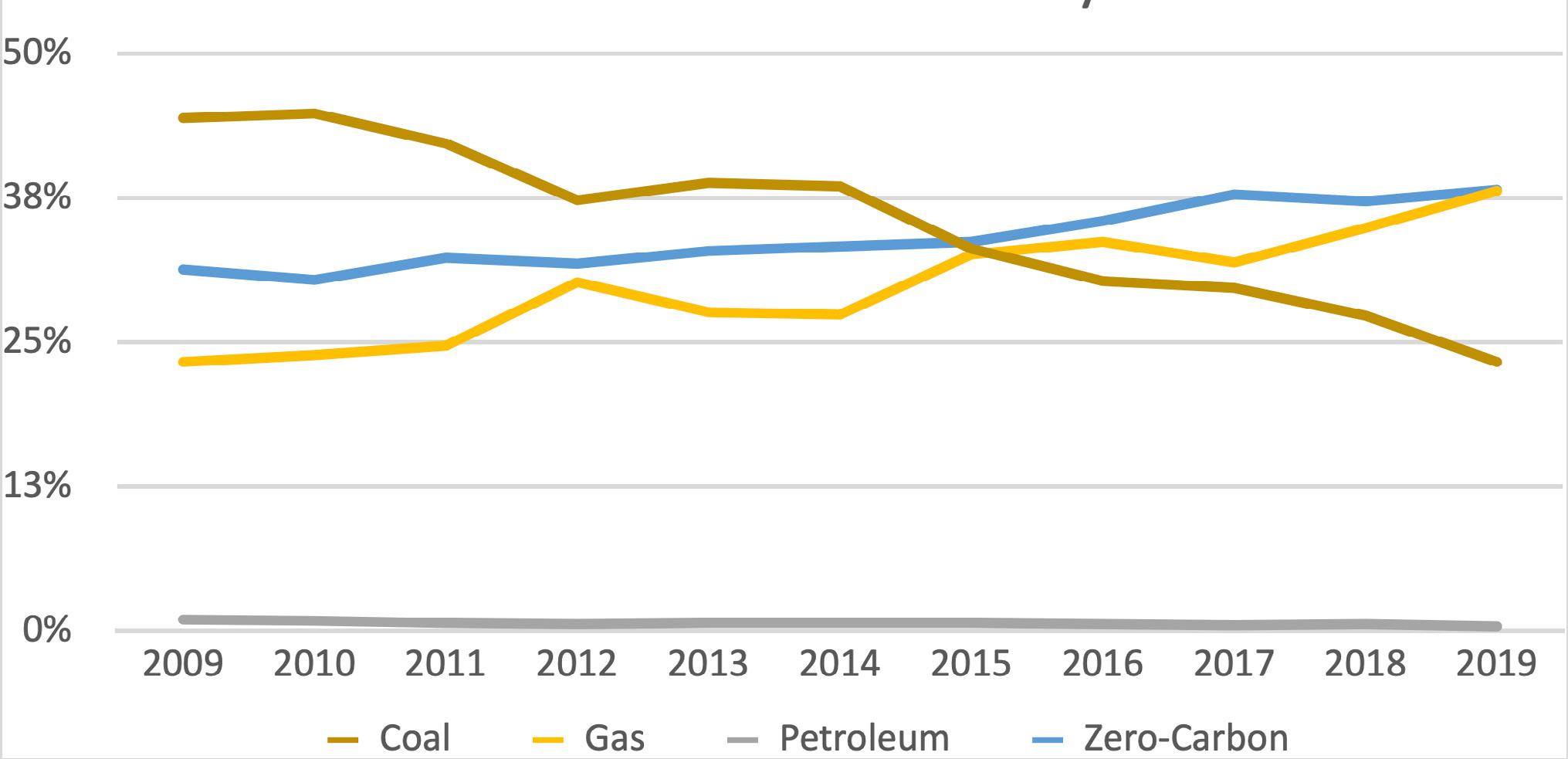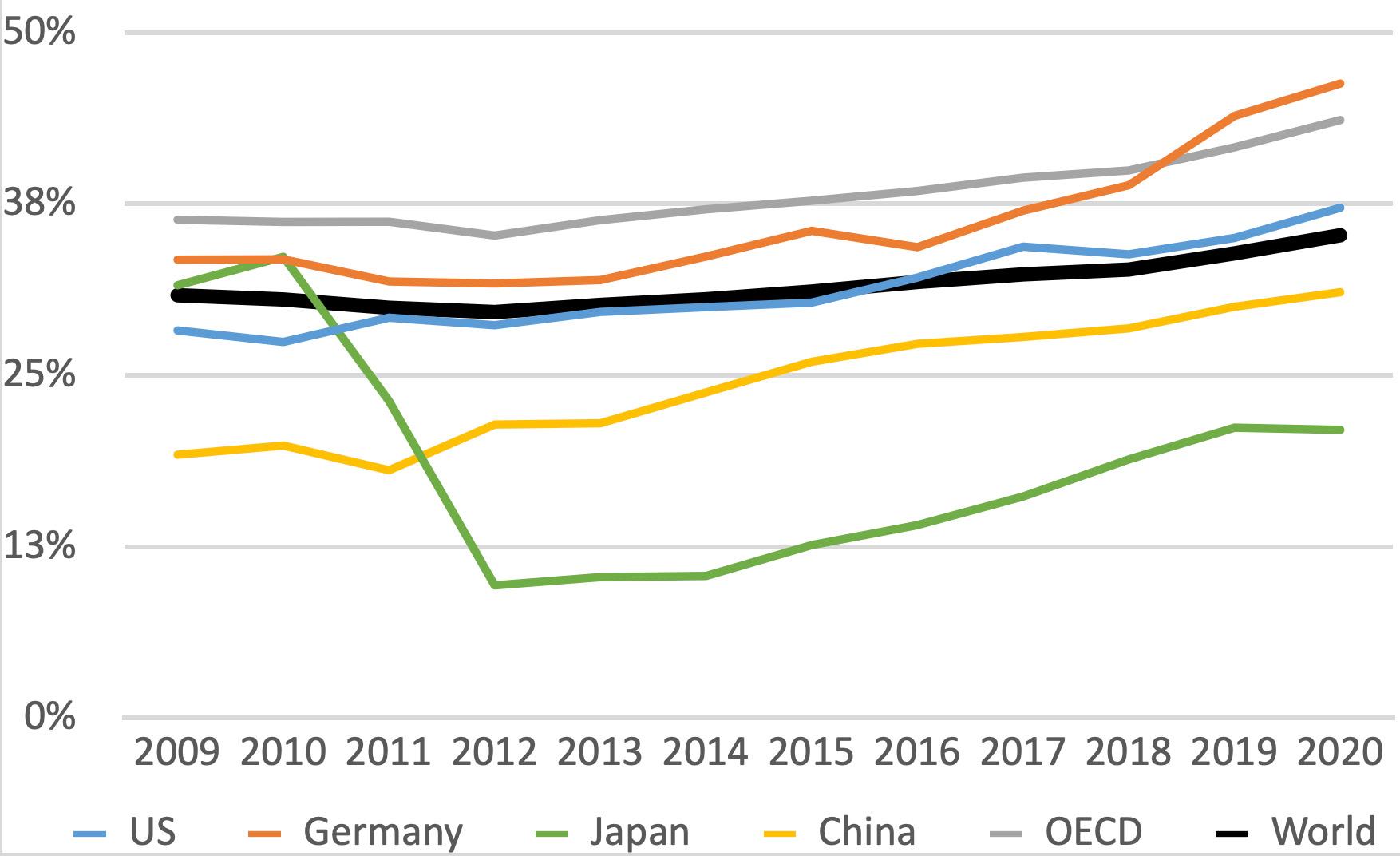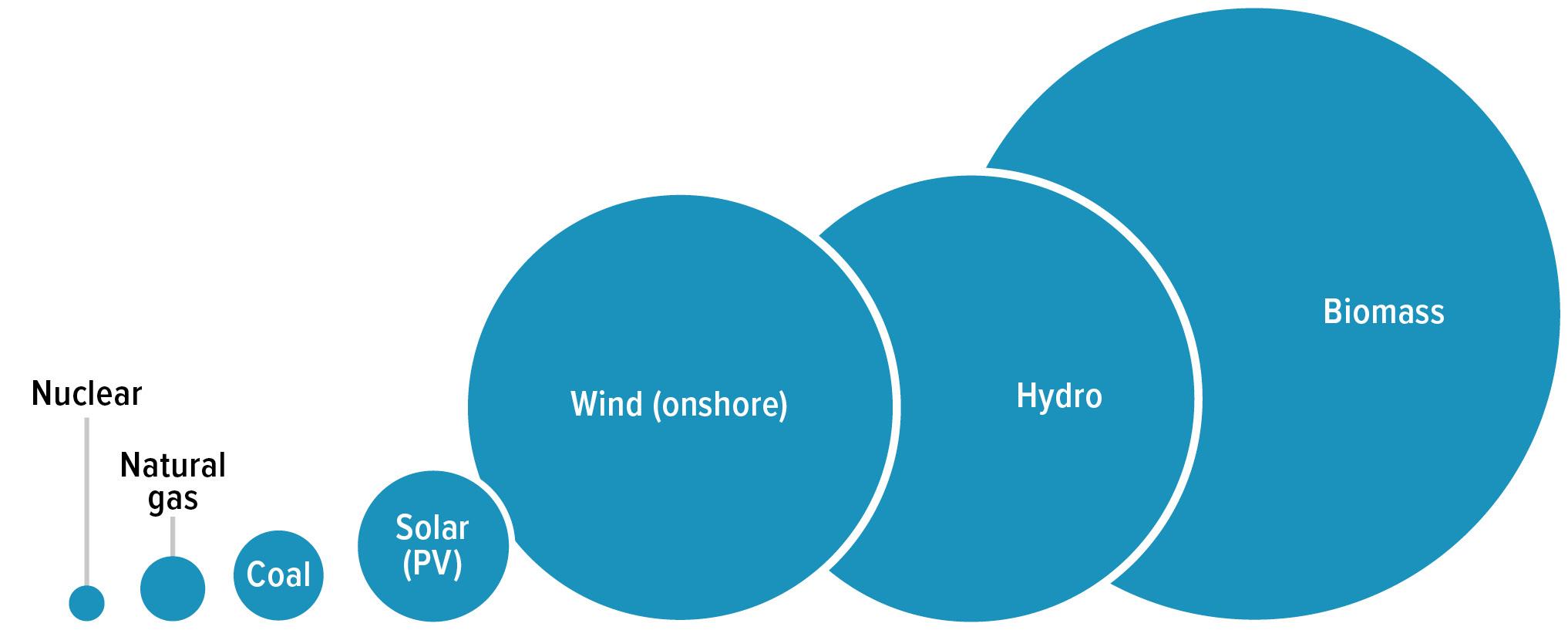
10 minute read
II. Challenges to Decarbonization
Worldwide strategies for decarbonization inevitably focus first on a substantial increase in the deployment of renewable energy. In Net Zero by 2050, the IEA anticipates that solar and wind power would constitute almost 70 percent of electric generation worldwide by 2050, and renewables overall (including hydropower) would represent almost 90 percent (see Figure 2), with most of the remainder coming from nuclear.48 However, the availability of renewable resources varies significantly by region, and renewable energy may be a more robust resource for power generation in some countries than in others. Furthermore, renewable resources are location constrained, and it may be challenging, given the structure of existing transmission systems and the difficulty expanding them, to move renewable power from the locations where it is generated to those where it will be used.
Renewable-energy generation is also time constrained. Especially in winter, when solar generation is severely constrained in mid-latitudes, unexpectedly calm conditions can lead to a disruptive shortfall of the remaining renewable (wind) generation.49 Without zero-carbon dispatchable generation, very large amounts of storage would be required to manage these shortfalls during infrequent, but inevitable, circumstances.
Figure 2: Global Electricity Generation by Source in IEA’s Net-Zero Emissions by 2050 Scenario
SOURCE: “NET ZERO BY 2050,” INTERNATIONAL ENERGY AGENCY, MAY 2021, FIGURE 3.10, HTTPS://WWW.IEA.ORG/REPORTS/NET-ZERO-BY-2050.
48 “Net Zero by 2050,” International Energy Agency, May 2021, https://www.iea.org/reports/net-zero-by-2050. 49 Armond Cohen, et al., “Clean Firm Power Is the Key to California’s Carbon-Free Energy Future,” Issues in Science and Technology, March 24, 2021, https://issues.org/california-decarbonizing-power-wind-solar-nuclear-gas.
Figure 3: British wind and gas generation during the fall and winter 2020–2021.

SOURCE: IAIN STAFFELL, ET AL., “Q1 2021 REPORT,” ELECTRIC INSIGHTS, 2021.
Germany, which has invested heavily in renewable energy through its energy transition (“Energiewende”), has recognized these conditions as “dunkelflaute,” or dark doldrums. Although renewable power covered nearly half of Germany’s power consumption for all of 2020, during a four-day stretch in January, renewable generation never exceeded 14–20 percent of demand.50 The United Kingdom saw an extended calm spell in its wind generation during late February and early March 2021 when, for more than eleven days, wind farms operated at just 11 percent of their rated capacity (see Figure 3). The generation deficit represented 2,300 gigawatt hours (GWh) of energy, more than two hundred and fifty times the energy stored in the UK’s largest pumped-storage facility, and ten thousand times the energy storable in the world’s largest battery-storage system in South Australia.51 Today, these deficits are typically covered with increased fossil generation. But, in the future, there will need to be dispatchable zero-emissions sources of power to address them. These conditions can extend over wide areas; even between Germany and Spain, despite their distance and different climates, there is roughly a one-third probability that the hours of low renewable generation coincide.52 Low wind conditions across Europe during the summer of 2021, along with limited imports of gas from Russia and other factors, drove European power prices to what were then record highs, though since exceeded by price increases resulting from the war in Ukraine..53
For these and other reasons, many analyses have concluded that, in addition to renewable energy, dispatchable low-carbon generation technologies such as nuclear power, natural-gas power plants with carbon capture, and generation with zero-carbon or renewable fuels, such as hydrogen, will likely be needed as part of carbon-neutral electric-power systems.54 However, the potential to implement these technology options also varies by region, depending on the resources available.
Electrification of Energy Use
Options to decarbonize elements of the electric-power infrastructure, although challenging, are further along in concept, development, and potential availability than options to decarbonize distributed uses of fossil energy, such as
50 Benjamin Wehrmann, “‘Dark Doldrums’ Highlight Supply Challenges for Germany’s Fossil Power Phase-Out,” Clean Energy Wire, February 3, 2021, https://www.cleanenergywire.org/news/dark-doldrums-highlight-supply-challenges-germanys-fossil-power-phase-out. 51 Iain Staffell, et al., “Q1 2021 Report,” Electric Insights, 2021, https://reports.electricinsights.co.uk/reports/q1-2021. 52 “Nuclear Power in a Clean Energy System.” 53 Pippa Stevens, “UK Energy Titan SSE Says Low Wind, Driest Conditions in 70 Years Hit Renewable Generation,” CNBC, September 29, 2021, https://www.cnbc.com/2021/09/29/sse-says-low-wind-dry-conditions-hit-renewable-energy-generation.html. 54 Sepulveda, et al., “The Role of Firm Low-Carbon Electricity Resources in Deep Decarbonization of Power Generation.”
space heating and transportation. For that reason, contemplated approaches to broad energy decarbonization generally begin with shifting more energy requirements to electricity, or “electrification.” The IEA concludes that, to achieve broader energy decarbonization, electricity will replace fossil fuels for industrial heat, transportation will rely primarily on electric drivetrains, and industrial processes will be converted to rely on electric power or zero-carbon fuels. In that view, electricity will rise to 49 percent of final energy consumption worldwide, compared to 20 percent today.55
Policies and corporate actions have begun to pursue the electrification objective. In the United States, President Joe Biden is aiming for half of new vehicles sold in 2030 to be some form of electric drive, and vehicle manufacturers from General Motors to Daimler have made commitments to shift their sales entirely to electric and hydrogen-powered vehicles.56 The California Energy Commission has adopted standards that will strongly incentivize use of electric heat pumps for space and water heating in all new construction.57 The Inflation Reduction Act contains a number of incentives for electrification. The addition of substantial vehicle charging and heating loads to the electric infrastructure will not only require more power, but will also change approaches to planning for resource adequacy and electric-system operation. Planning will now need to contemplate the timing of vehicle charging demands, potentially create incentives, and encourage technical management approaches to optimize them. Perhaps more challenging, electrification of space heating will require changing the planning mindset, since peak load requirements in some regions may shift to winter (see Figure 4).58
Reliability and Resilience
The LNG supply shock throughout Asia in early 2021, mentioned earlier, is only one example of the challenges to maintaining reliable energy supply as extreme weather events driven by climate change cause unanticipated demand and disrupt energy supply. The Asian gas-supply challenges of winter 2020–2021 evolved into a supply shortage and price spikes in both Asia and Europe before becoming dramatically worse as a result of Russia's invasion of Ukraine.
Figure 4: Peak Load by Season

Season
Spring Fall Summer Winter Peak Load (GW) 1 20 40 60 80 ≥ 100
SOURCE: ELLA ZHOU AND TRIEU MAI, “ELECTRIFICATION FUTURES STUDY: POWER SYSTEMS OPERATION WITH NEWLY ELECTRIFIED AND FLEXIBLE LOADS,” JUNE 17, 2021. REPRINTED WITH PERMISSION FROM THE NATIONAL RENEWABLE ENERGY LABORATORY, HTTPS://WWW.NREL.GOV/DOCS/FY21OSTI/80167.PDF, ACCESSED NOVEMBER 2, 2021.
55 “Net Zero by 2050.” 56 “Fact Sheet: President Biden Announces Steps to Drive American Leadership Forward on Clean Cars and Trucks,” White House, press release, August 5, 2021, https://www.whitehouse.gov/briefing-room/statements-releases/2021/08/05/fact-sheet-president-biden-announces-steps-to-drive-american-leadership-forward-onclean-cars-and-trucks; Neal E. Boudette and Coral Davenport, “G.M. Will Sell Only Zero-Emission Vehicles by 2035,” New York Times, January 28, 2021, https://www.nytimes.com/2021/01/28/business/gm-zero-emission-vehicles.html; Jack Ewing, “World’s Largest Long-Haul Truckmaker Sees Hydrogen-Fueled Future,” New York Times, May 23, 2021, https://www.nytimes.com/2021/05/23/business/hydrogen-trucks-semis.html. 57 Kavya Balaraman, “California Greenlights First-of-Its-Kind Energy Code to Encourage Electrified Buildings,” Utility Dive, August 12, 2021, https://www.utilitydive.com/news/california-greenlights-first-of-its-kind-energy-code-to-encourage-electrifi/604863. 58 “Electrification Futures Study,” National Renewable Energy Laboratory, https://www.nrel.gov/analysis/electrification-futures.html.
In the United States, events in California and Texas highlighted similar vulnerabilities. During the summer of 2020 in California, there were rolling blackouts over the course of several days driven by a heatwave that extended across the western United States.59 A variety of factors contributed to the event, including retiring fossil generation before replacement supply was put in place, lack of clear accountability because of the shared roles of various state agencies, and overreliance on imports from outside California, which were not available because widespread weather conditions left the entire region short of supply.60 Contracts for new capacity intended to meet peak demand, much of it battery storage, have since been accelerated. Much of the region continues to face potential shortfalls of peak capacity and to continue “over-reliance on imports to maintain resource adequacy.”61 In late summer 2022, California experienced another extreme heatwave and record power demand, but avoided rolling outages through a successful emergency public appeal to reduce power use.
In February 2021 in Texas, more than one hundred and fifty people died, millions of people lost access to clean water, and there was widespread property damage during extreme winter weather. Initially, state officials blamed the unreliability of renewable energy. However, it soon became clear that unavailable fossil-powered generation accounted for most of the shortfall. The causes turned out to include a failure to weatherize all types of power plants—including natural gas, wind, and nuclear—as well as natural-gas pipeline systems. In addition, there were gas shortages caused by rising demand throughout the country during the cold spell, and an overall lack of coordination.62 The experience clarified that even natural-gas power plants may not be reliable if gas-supply networks are not robust, a situation similar, in some ways, to the Japanese experience in early 2021, though the cause of the fuel-supply challenges was different.
The recognition that power systems must change to rely more on variable renewable power, and that climate change will alter the conditions under which power-system reliability is tested, has caused a reconsideration of approaches to reliability. In the past, weather was considered only as a factor driving demand, and resource adequacy focused on managing discrete, independent mechanical or electrical failures, such as generating-unit outages. In the future, with more variable resources supplying power, weather will drive both supply and demand, and correlated weather-related events will determine reliability.63 As a result, the conventional approach of designing a system to meet peak-load conditions with a static reserve margin will no longer be appropriate, and a chronological evaluation of all hours of the planning period will be required so the periods of shortfall can be identified.64
Furthermore, climate change means that historical weather conditions may not accurately predict future conditions. During the California heatwave, some of the highest temperatures in the past thirty-five years were recorded across the entire western United States. Similarly, during the 2021 winter storm, Texas experienced near-record low temperatures.65
The combination of increased reliance on variable renewable generation, and the need to anticipate potentially increased volatility in weather-related demand, requires a stronger commitment to energy storage and fuel reserves. In the past, fuel reserves have been considered only in the context of fossil fuel, whether in storage facilities or in the ground waiting to be produced. In the future, storage will need to include long-term power storage (such as advanced batteries that are only now being demonstrated) and potentially hydrogen (though hydrogen storage may be challenging without favorable geography). These conditions also argue for the value of dispatchable zero-carbon energy resources, particularly nuclear power, which because of its long fuel cycles maintains extensive power reserves onsite (conventional reactors have refueling cycles more than a year long, and some advanced reactors have even longer cycles or can continuously refuel).
Future planning for reliability and resilience will need to be much more complete, and incorporate a wide range of factors, including
59 “2021 Summer Readiness,” California Independent System Operator, http://www.caiso.com/about/Pages/News/SummerReadiness.aspx. 60 Ivan Penn, “Poor Planning Left California Short of Electricity in a Heat Wave,” New York Times, August 20, 2020, https://www.nytimes.com/2020/08/20/business/ energy-environment/california-blackout-electric-grid.html; Cheryl A. Lafleur, “What’s Ailing California’s Electric System?” Columbia Climate School, September 2, 2020, https://news.climate.columbia.edu/2020/09/02/whats-ailing-californias-electric-system; Jeff St. John, “California’s Race to Secure Its Grid Against Summer Blackouts,” Canary Media, May 19, 2021, https://www.canarymedia.com/articles/californias-race-to-secure-its-grid-against-summer-blackouts/. 61 St. John, “California’s Race to Secure Its Grid Against Summer Blackouts.” 62 Edward Kump, Mike Lee, and Carlos Anchondo, “Documents Reveal Natural Gas Chaos in Texas Blackouts,” Energywire, May 20, 2021, https://www.eenews.net/stories/1063733071. 63 For example, to address the loss of wind generation in March 2021, gas-fired generation in Britain increased 20 percent in the first quarter of 2021 compared to the same quarter in the prior year. Staffell, et al., “Q1 2021 Report.” 64 “Redefining Resource Adequacy for Modern Power Systems,” Energy Systems Integration Group, 2021, https://www.esig.energy/resource-adequacy-for-modern-power-systems. 65 Ibid.
•correlated load and supply variability due to weather conditions, overextended geographical areas to account for potential limitations on imports (traditionally resource adequacy has focused only on the load variability);
•weather conditions outside normal or historical bounds;
•probabilistic likelihood of mechanical failures (this is traditionally the focus of reliability analysis);
•transmission constraints (also a traditional concern); and
•charging and discharging energy-limited storage resources. Future power systems will need to consider the characteristics of specific components that support reliability and resilience, including demand management, which may be greatly expanded as a result of digital control over the timing of certain elements of demand (e.g., space and water heating, vehicle charging). In addition, they will need to consider resilience of the power-supply system, both to direct weather impacts and fuel supply. Such considerations will place a premium on resilient supply options.





